Huron High Musicians Meet a Master
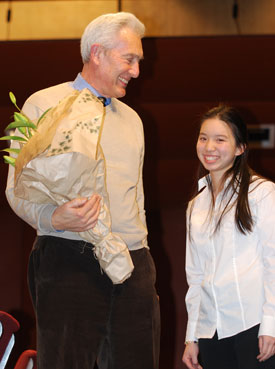
Arnold Steinhardt of the Guarneri String Quartet received a bouquet from Emily Hsiao, a Huron High School student whose email invitation led to his spending two hours working with the school's student musicians on Monday.
He’d performed on stage at Rackham Auditorium the previous night, but on Monday afternoon Arnold Steinhardt sat quietly in the audience, this time at Huron High School, listening to the school’s symphony orchestra rehearse Saint-Saëns’ Symphony No. 3 in C minor, Opus 78.
“Sounds great!” he said when the last note fell silent – and then he asked to hear more.
For two hours, Steinhardt – lead violinist for the renowned Guarneri String Quartet – shared his insights, gave advice and even played a bit on a violin borrowed from one of the students. It was an up-close exchange that came about simply because one of his fans in the orchestra asked him to come.
That fan was Emily Hsiao, a Huron High senior, a violinist and co-president of the school’s symphony orchestra. She knew the quartet was coming to Ann Arbor as part of its final season of performances – after 45 years together, the group plans to retire. She’d read Steinhardt’s book, “Indivisible By Four: A String Quartet in Pursuit of Harmony.” And so she sent him an email in August which read, in part: “We would love it if the Guarneri String Quartet would consider the possibility of coming to Huron High School and teach us more about [chamber music] – even just watching the quartet work together would be an amazing experience altogether.”
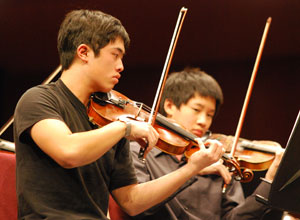
Huron High students Charles Lu, concertmaster, and Daniel Lee, assistant concertmaster, play in the school's symphony orchestra during rehearsal on Monday.
To her surprise, he said yes.
Well, not completely: The other members of the quartet – John Dalley, Michael Tree, and Peter Wiley – couldn’t make it. But Steinhardt’s two hours amounted to a master class for the students, with lots of specific advice about the nuances of their performance. It’s advice they’re eager for, said Chris Mark, who teaches the orchestra and other music classes at Huron. They’re preparing for Orchestra Night at Hill Auditorium – “Oh, the Hill Auditorium,” Steinhardt quipped – an evening of performances by string programs at the district’s middle and high schools, held this year on Feb. 19.
So Steinhardt talked to the orchestra about the nuances of phrasing, of working in unison to create the kind of musical arcs that are far easier for individual performers to achieve alone. He spoke of dynamic range, an effort to balance the brass against the strings. He answered questions from the students, revealing that his favorite recordings by the quartet were Beethoven’s complete string quartets, and their recordings with the acclaimed pianist Arthur Rubenstein. “Whenever we play those pieces, I still hear the way he played them.”
During the second hour, Steinhardt heard a chamber ensemble play Mendelssohn’s Octet in Eb Major, Op. 20, a piece the Guarneri String Quartet has been playing this year as well, partnering with another quartet. Steinhardt praised the performers, but as the groups got smaller, he put them through their paces. To the chamber ensemble: “You started at one tempo and you finished at a completely different tempo!” His message: Have a basic tempo and stick with it – ”otherwise, it’s just all over the place.”
After brothers Dan and Phil Lee – on violin and cello – played the duet Pasacaglia by Handel/Halvorse, Steinhardt said, “It’s fun to play, isn’t it? Kind of scary, but fun.” (It also looked physically exhausting – Phil Lee shook out his cramped hands after finishing the performance.) Steinhardt asked Dan Lee to pay more attention to vibrato, saying it’s one of the greatest gifts that a string performer has. “I mean, the poor pianists! I feel so sorry for them because they can’t vibrate.”
He asked whether they could keep the strength of their playing while making it more like singing. “Try it, would you?” Steinhardt said. And after they did: “This way it’s not ‘Pow! Bang!’ It has more of a noble, grand feeling to it.”
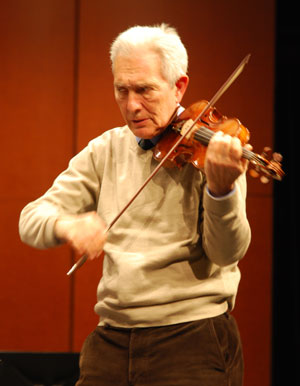
Arnold Steinhardt borrows Kevin Hsiao's violin to demonstrate how a piece by Bach should convey a sense of dance.
The final performance was a violin solo by Kevin Hsiao, who played Partita in D minor for solo violin (Allemande), by J. S. Bach. (Kevin, a junior, is Emily Hsiao’s brother.) Afterward, Steinhardt commented that all music has a kind of dance impulse in it, and that you should feel the impulse as you play or listen to the piece. And then: “Can I have the violin?” – a sentence which evoked an audible gasp from those in the auditorium.
So those gathered on Monday afternoon, including students and a few current and former teachers, were treated to brief bit of Bach by a virtuoso – not a performance so much as a peek into the mechanics of a master.
As the bell rang for changing classes, Steinhardt too had to leave. Or tried to, as students lined up for photos and to get his signature on their favorite sheet music. He accommodated them graciously before heading out, getting a ride back to town by the Hsiao family. In the evening he was scheduled for a book-signing at Shaman Drum Bookshop to promote his more recent book, “Violin Dreams.”




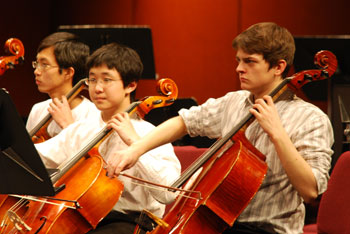
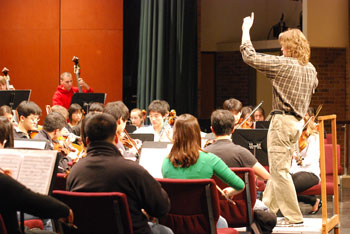

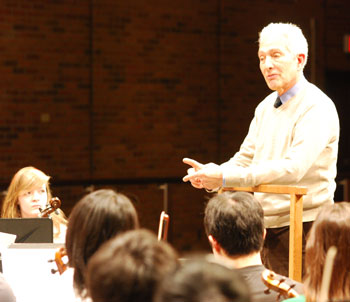
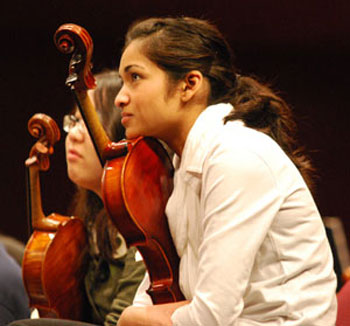
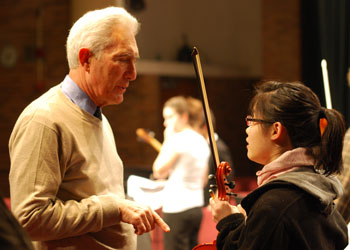
Mary, that’s a wonderful story. Thanks.
This is just a wonderful story to read. Ann Arbor has so many wonderful opportunities for those who live here and grow up here. Simply great to read.
My son plays in the Huron Symphony Orchestra and the level of musicianship is amazing. The kids absolutely love music and they work so hard. What a great story. Thank you.